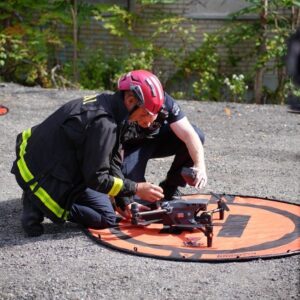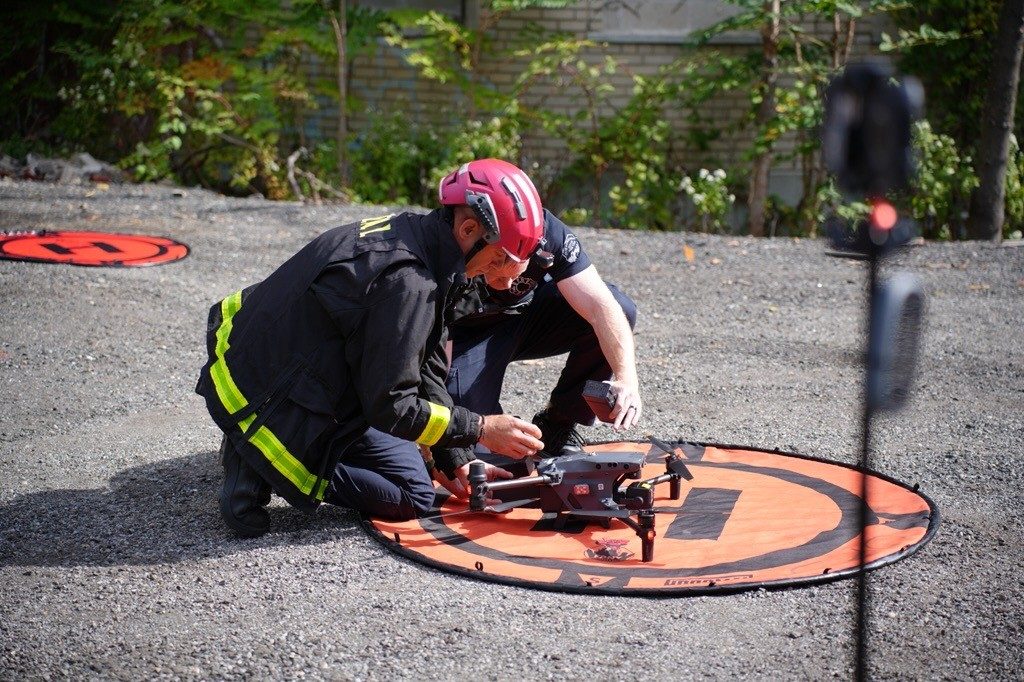(Part of a series on the drone community’s response to natural disasters)
Last week marked the 12th anniversary since Hurricane Sandy slammed into the U.S. East Coast, causing tremendous devastation across wide areas of New York and New Jersey. In New York City, at least 43 people died as a result of the storm, which caused the city’s subway system to flood, and resulted in numerous businesses being destroyed by fire, including more the 100 homes in Breezy Point in Queens. In the years since that disastrous storm, the city has upgraded its disaster response efforts with the help of drones, which can warn people in low-lying areas of imminent flooding risk, breach storm-damaged buildings to help rescue survivors and conduct post-storm aerial surveys to help assess the extent of the damage.
Drones to play a big part in response to next major NYC storm
By DRONELIFE Features Editor Jim Magill

 On October 1, several agencies of the New York City government conducted a joint exercise on Staten Island to demonstrate the use of UAVs in response to a major disaster event, such as Superstorm Sandy, which walloped the city and a broad swath of the U.S. East Coast.
On October 1, several agencies of the New York City government conducted a joint exercise on Staten Island to demonstrate the use of UAVs in response to a major disaster event, such as Superstorm Sandy, which walloped the city and a broad swath of the U.S. East Coast.
Coordinated by the New York City Department of Emergency Management (NYCEM), in collaboration with the New York City Police Department (NYPD) and the Fire Department of New York (FDNY), the demonstration illustrated the city’s embrace of the use of drones as a critical tool in managing the response to disaster events.
In one phase of the demonstration, emergency management personnel used a Brinc breaching drone to demonstrate how the agency could gain access to a storm-damaged building where survivors may be trapped, without endangering emergency responders. The emergency response team employed the drone’s ability to shatter windows to get inside the old, abandoned Seaview Children’s Hospital.
Jose Rolon, citywide interagency coordinator, said the breaching drone would be deployed to access buildings whose main entrances were blocked by floodwaters, as was the case with many structures in the aftermath of Sandy.
”You may be able to breach the window on the second floor and fly in to do an interior search of the building,” he said. “We used the breaching drone in a scenario where there was a building with holes in the floor — very dangerous — where you wouldn’t want to initially send rescuers.”
With the use of the drone, emergency responders would be able to search the building for any trapped victims, and if any were found, communicate with those victims that help was on the way.

 In another aspect of the demonstration event, staged on Fox Beach in an area hard-hit by Sandy, the NYCEM team showed how responders could use a drone to aid victims who had been pulled out to sea by floodwaters. Over the summer, officials had introduced strategically deployed drones equipped with flotation devices that could be dropped to swimmers in distress in the waters off the city’s beaches.
In another aspect of the demonstration event, staged on Fox Beach in an area hard-hit by Sandy, the NYCEM team showed how responders could use a drone to aid victims who had been pulled out to sea by floodwaters. Over the summer, officials had introduced strategically deployed drones equipped with flotation devices that could be dropped to swimmers in distress in the waters off the city’s beaches.
NYCEM Specialist Wessley Doskocil said these drones could play a major part in water rescues in the wake of a major storm as well as being put into regular use during the summer swimming season.
“The emergency flotation device would be helpful, once the lifeguards are off duty in the early evening, and while there’re still people that stay in the water for hours,” he said. “We have created an interagency task force for this operation with the New York City Parks Department along with the lifeguards, police department, fire department and police management.”
The different agencies involved in the task force share a radio channel, which they would use to coordinate the deployment of the life-saving drones.
“Anyone on the channel would call out for the rescue on the radio, the drone would deploy and it would get a visual, and that visual would be able to be provided to all our leadership all the way up through City Hall if needed for situational awareness and also to initiate a rescue,” Doskocil said.
In addition to the two scenarios for the use of UAVs played out in the demonstration, city officials have planned out a number of other uses for drones in responding to disasters. For example, in August, the city rolled out drones equipped with loudspeakers, which were deployed across the boroughs of Queens, the Bronx, Brooklyn and Staten Island, to send warnings of the imminent danger of flash floods to residents in basement and ground-floor apartments.
Emergency responders also are trained in the use of UAVs to help facilitate communications during disaster-response incidents and to assess damages post-disaster, Doskocil said.
“We utilize our UAS to provide an operating picture back to our emergency operations center, to our executive staff, and to leadership in government so that they are able to get a bird’s eye view of what’s going on at the scene,” he said.
Drones can be a particularly useful tool in the response to coastal storms, which can affect multiple large areas of the city. “When it comes to large-scale disaster response in the city, we use our drones to provide a picture of what’s going on. It gives the decisionmakers the ability to sees whatever has occurred, the destruction that’s occurred.”
Emergency management personnel also can deploy drones to create digital maps showing what the city’s communities look like before a major storm hits, which can then be compared with post-storm maps of the same areas, in order to assess the extent of storm damage.
“We’ve flown the coastline of New York City and have downloaded and created what we call B-storm datasets that show how the coastal communities in the five boroughs of New York City look now,” Doskocil said. “God forbid there should be another Sandy-type event, we’d be able to fly almost immediately post-storm the same pre-programmed route.”
The Big Apple’s increased use of drones in disaster response reflects the city’s embrace of UAV technology across a number of applications such as law enforcement and firefighting. The city has devised a Citywide Incident Management System (CIMS) that delineates the command structure in the response to certain types of incidents.
For example, in the case of a two-alarm fire, FDNY Robotics will launch one of its drones to support the on-scene incident commander and provide a visual of the scene. NYCEM personnel will also go out to the site to provide technological support for the firefighters.
“There’re other incidents — like when we had a large-scale building collapse in lower Manhattan – when we all flew. It was kind of like a unified operation,” he said. “The police department flew, we flew, the fire department flew. Then over the course of several days we kept a bird in the sky all the time, watching the remainder of the building to see if it shifted or moved, especially on the overnight.”
Want DRONELIFE news delivered to your inbox every weekday? Sign up here.
Read more:

 Jim Magill is a Houston-based writer with almost a quarter-century of experience covering technical and economic developments in the oil and gas industry. After retiring in December 2019 as a senior editor with S&P Global Platts, Jim began writing about emerging technologies, such as artificial intelligence, robots and drones, and the ways in which they’re contributing to our society. In addition to DroneLife, Jim is a contributor to Forbes.com and his work has appeared in the Houston Chronicle, U.S. News & World Report, and Unmanned Systems, a publication of the Association for Unmanned Vehicle Systems International.
Jim Magill is a Houston-based writer with almost a quarter-century of experience covering technical and economic developments in the oil and gas industry. After retiring in December 2019 as a senior editor with S&P Global Platts, Jim began writing about emerging technologies, such as artificial intelligence, robots and drones, and the ways in which they’re contributing to our society. In addition to DroneLife, Jim is a contributor to Forbes.com and his work has appeared in the Houston Chronicle, U.S. News & World Report, and Unmanned Systems, a publication of the Association for Unmanned Vehicle Systems International.
Miriam McNabb is the Editor-in-Chief of DRONELIFE and CEO of JobForDrones, a professional drone services marketplace, and a fascinated observer of the emerging drone industry and the regulatory environment for drones. Miriam has penned over 3,000 articles focused on the commercial drone space and is an international speaker and recognized figure in the industry. Miriam has a degree from the University of Chicago and over 20 years of experience in high tech sales and marketing for new technologies.
For drone industry consulting or writing, Email Miriam.
TWITTER:@spaldingbarker
Subscribe to DroneLife here.


